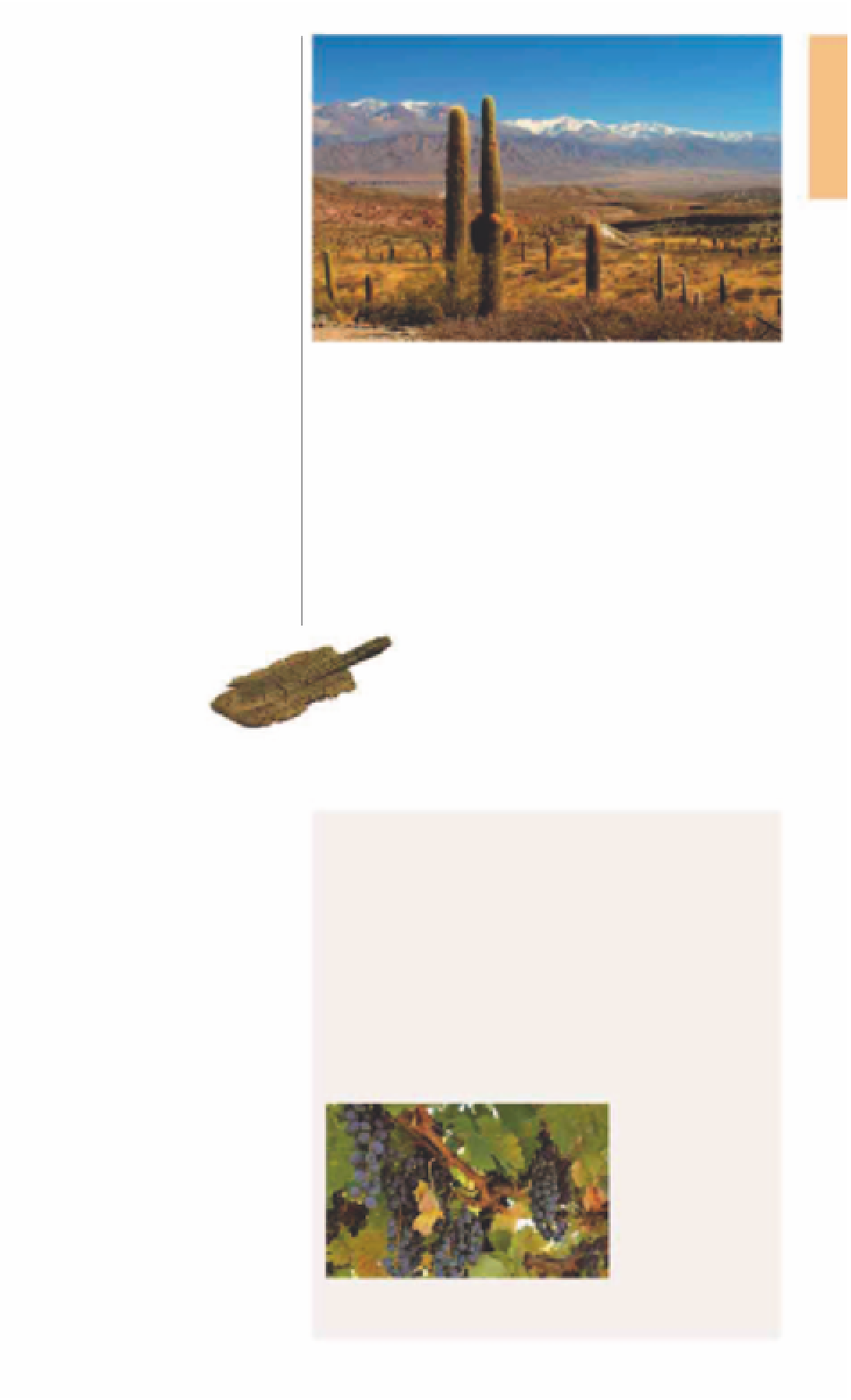Travel Reference
In-Depth Information
away from town is the
Estancia Colomé, a huge
vineyard and agricultural estate
owned by Swiss businessman
Douglas Hess. It has an art
gallery, a smart restaurant, a
good library, and an open-
air pool with sweeping views
of the beautiful surrounding
mountains.
p
Cachi
Road
map
B1. 85 miles (136 km) N of
Cafayate.
*
4,000.
@
n
Ave
Guemes & Benjamin Solillas, (03868)
491-902.
_
Fiesta de San José (Mar).
The 16-ft (5-m) tall
cardones
at the Parque Nacional Los Cardones
a
Parque Nacional
Los Cardones
Road
map
B1. 16 miles (25 km) N of
Cafayate.
@
n
Ave San Martín s/n,
(03868) 496-005.
Open
daily.
∑
parquesnacionales.gov.ar
Created in 1996, the 158-acre
(64-ha) Parque Nacional Los
Cardones protects the
cardón
cacti that cover this dusty valley,
as well as other species of flora
that are suited to
the arid climate.
The preserve was
established to protect
the
cardones
, which were
widely being used for
firewood or to make
furniture. Although
some of the gigantic cacti can
reach heights of 16 ft (5 m),
these plants grow only a few
milli meters every year. They
are found between 8,858 ft
(2,700 m) and 18,044 ft
(5,500 m) above sea level.
Rare bird species such as the
endemic Steinbach's canastero
and the little-known Zimmer's
tapaculo can be spotted
throughout the park, along
with condors, falcons, and
numerous species of tyrant and
finch. Parque Nacional Los
Cardones is also an important
paleontological site, containing
traces of dinosaur footprints
dating from more than
70 million years ago.
Founded in the 18th century,
Cachi is a quiet village with a
rustic atmosphere, retaining
only a few original adobe
properties from that period. This
picturesque village, known for
its pretty plaza lined with palms
and orange trees, sits at the foot
of the towering, snowcapped
Nevado del Cachi which stands
at 20,932 ft (6,380 m). The small
Museo Arqueológico Pío
Pablo Díaz
to the east
of the plaza has
displays of items
used by the origi-
nal inhabitants of
Valles Calchaquíes.
Also worth a visit is
the extensively restored
Iglesia
San José
, north of the main
plaza, with a classic white façade,
wooden floor, and remarkable
cactus-wood altar. Small shops
around the town center sell local
crafts that include ceramics and
ponchos with lovely designs.
At 7,480 ft (2,280 m) above
sea level, Cachi's microclimate is
pleasant for most of the year.
The rainfall it receives keeps the
maize terraces, vineyards, and
plantations of peppers and
legumes green and healthy. A
drive to the nearby hamlet of
Cachi Adentro offers lovely
views of farmlands interspersed
with carpets of red pepper
fields drying in the sun.
Wooden shovel, Museo
Arqueológico
The Wines of Salta
There has been winemaking in the scattered oases of the
province of Salta since the days of the Spanish conquest. In
the 17th century, winemakers in the area supplied priests and
monks, who needed wine for mass. Today, there are
terroirs
at a
variety of altitudes, ranging from 5,577 ft (1,700 m) in Cafayate and
6,561 ft (2,000 m) in Yacochuya Comarca de la Viña to 7,874 ft
(2,400 m) in Colomé. Benefiting from long hours of sunshine and
fast-flowing streams fed by rains that wash off the high peaks to the
west, the vineyards of Salta are some of the most visually striking
in the world. Cabernet Sauvignon and Malbec grapes prosper here,
as do Chardonnay and Chenin. A small number of vineyards are
also succeeding with Tannat, a grape more often associated with
Uruguay. The most
famous varietal from
Salta is the aromatic
Torrontés white, a
wine that has fallen
out of favor in Europe
but thrives in this
region. Its success
has made the wine
Argentina's most
popular after Malbec.
E
Museo Arqueológico Pío
Pablo Díaz
Juan Calchaquí s/n.
Te l
(03868) 491-
080.
Open
10am-7pm Mon-Fri,
10am-6pm Sat, 11am-2pm Sun.
Closed
public hols.
Grapes ready to be picked at a
bodega




































